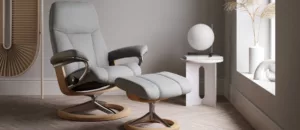If you’re interested in purchasing a leather sofa you’re probably already aware, to some degree, that there are varying qualities of leather available. You’d be forgiven, too, for not knowing the differences between the options out there. So to help, we’ve created this handy leather care guide that outlines the benefits of each leather type as well as care information for when your new suite is delivered.
Choosing Your Furniture

Types of Leather
- Aniline & Sauvage Leather – The most attractive and expensive leather. Aniline Leather has been dyed using aniline dyes and has little to no protection. It is the highest quality leather and natural blemishes will be noticeable. It is also susceptible to shade and colour variations due to its lack of protective coating.
- Semi-Aniline Leather – Semi-Aniline Leather is designed to feel and appear like fully Aniline leather but has the protective pigment coating to provide more resistance. Natural hide characteristics will still appear, but with the benefit of a protective surface finish.
- Pigmented Leather – Pigmented leather is a dyed leather, which is coated with pigmentation for better protection. The dye will disguise shade variances and is more resistant to wear and soiling. The leather will not feel as soft as Aniline leather, but will be easier to care for.
- Bicast Leather – Bicast leather has a partially natural leather layer and a synthetic polyurethane layer. Both components are bonded together and provide high resistance to soiling.
- Antique Leather – Antique leather has a two part surface pigment process. During the production of the upholstery, part of the top coat is rubbed off to expose the contrast colour underneath. Over time, the top colour will wear away to give an attractive antique appearance.
- Split Leather – Split leather is the bottom portion of the hide, which is typically not as durable as the top grain. Made with several pieces of leather, split leather is typically dyed more than alternative leathers.
Caring For Your Furniture

When you receive your furniture:
- Always follow your manufacturer’s cleaning and care label instructions. For recliners, it’s important that operating and care instructions are followed closely.
- Keep pets and sharp objects away from your suite.
- Don’t place your furniture in direct sunlight or next to heat sources such as radiators. This will accelerate discolouration and possibly cause the leather to crack.
Staingard Warranty
After purchasing your upholstery, it’s important to consider protecting your purchase against any accidental damages/spillages. For peace of mind, we recommend you purchase Staingard Cover. Staingard provides a 5 year care guarantee, which includes a leather or fabric care kit. Staingard cover also includes a team of professional technicians that will resolve any issues you may have, that the care kit can’t take care of. Find out more here.
Leather Care Guide for Maintenance
- Purchase protective arm caps where possible as this is the area most likely to show wear.
- Sitting on the front edges of cushions or on the arms of furniture may cause distortion or damage.
- Reversible seat and back cushions should be turned weekly and plumped up to maintain their shape.
- To avoid damaging your leather suite, if you spill something on it, simply act quickly and mop up excess liquid with a clean white cloth. Do not use detergents or rub the spillages into the leather.
- On pigmented leather, use a vacuum and a slightly damp cloth to remove dust. For aniline leather (Non-protected leather), use specifically designed products and follow care information carefully.
- Perspiration can cause colour loss and cracking to leather (certain medication accentuates this). Cleaning instructions must be regularly followed to minimise risks of this happening.
- Non-colourfast clothing such as denim can stain lightly coloured leathers.
- We recommend cleaning your upholstery at least once a year and before soiling becomes in-grained. Clean all parts of a suite together, as slight colour changes can sometimes occur.
- Plump your cushions at the end of every day of use, particularly those filled with feather or fibre.
For more information on our leather care guide please contact us.
